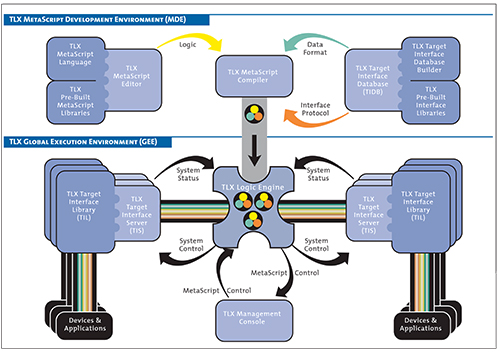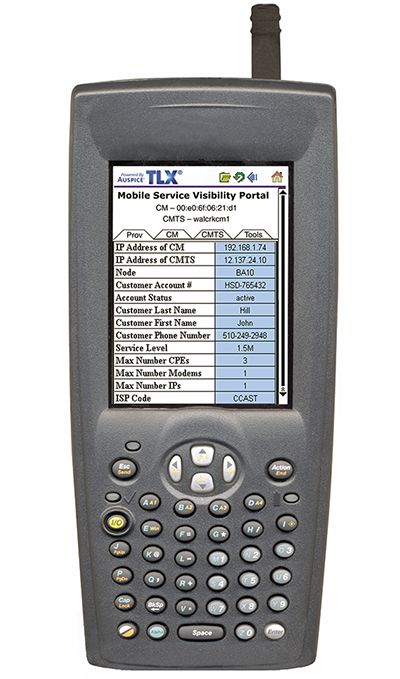The Logical Extension
The same software controlling autonomous and crew-assisted operations for the International Space Station (ISS) is enabling commercial enterprises to integrate and automate manual operations, also known as decision logic, in real time across complex and disparate networked applications, databases, servers, and other devices, all with quantifiable business benefits.
Auspice® Corporation, of Framingham, Massachusetts, developed the Auspice TLX® (The Logical Extension) software platform to effectively mimic the human decision-making process. Auspice TLX automates operations across extended enterprise systems, where any given infrastructure can include thousands of computers, servers, switches, and modems that are connected, and therefore, dependent upon each other.
The concept behind the Auspice software spawned from a computer program originally developed in 1981 by Cambridge, Massachusetts-based Draper Laboratory for simulating tasks performed by astronauts aboard the Space Shuttle. At the time, the Space Shuttle Program was dependent upon paper-based procedures for its manned space missions, which typically averaged 2 weeks in duration. As the Shuttle Program progressed, NASA began increasing the length of manned missions in preparation for a more permanent space habitat. Acknowledging the need to relinquish paper-based procedures in favor of an electronic processing format to properly monitor and manage the complexities of these longer missions, NASA realized that Draper's task-simulation software could be applied to its vision of year-round space occupancy.
In 1992, Draper was awarded a NASA contract to build User Interface Language software to enable autonomous operations of a multitude of functions on Space Station Freedom (the station was redesigned in 1993 and converted into the international venture known today as the ISS). The resulting software was certified by NASA and installed on the Space Station's Command and Control and Payload Control Processors, through Marshall Space Flight Center and Johnson Space Center.
Known as Timeliner, the software was used for the first time aboard the ISS in June 2003 to autonomously activate and control experiment payloads in the Microgravity Science Glovebox, a sealed container with built-in gloves that provides a safe, enclosed workspace for investigations conducted in the low-gravity environment. It is further anticipated to automate other ISS procedural tasks typically performed by human operators—or those that execute a control process—including vehicle control, performance of preflight and postflight subsystem checkout, and handling of failure detection and recovery. While Draper Laboratory additionally received a patent on Timeliner in 1998, the software was licensed to Auspice in 1997, for exclusive use in commercial markets.
"We took the baseline version Timeliner and commercialized it as TLX," said Rick Berthold, Draper's former ISS Timeliner lead engineer who cofounded Auspice and remains as its chief technical officer. "The original Timeliner gave us the revolutionary English-like development language and an ultra-reliable runtime environment. We greatly extended the utility of the language, added interconnectivity to networking devices, servers, databases, and application software, and built a limitless distributed execution environment that could process up to millions of simultaneous events."
As a software platform, Auspice TLX uses the English-like language Berthold referred to, called MetaScript,™ to provide rapid development and scalable, real-time execution environments. The role of the TLX MetaScript is to marshal and coordinate the capabilities of the disparate enterprise systems in order to accomplish an activity or "mission." The language was designed in an accessible format so that content experts who do not know how to write computer programs can quickly build TLX applications, as well as anticipate and respond to events in real time. Many of the functions provided by the TLX MetaScript parallel those of a human operator for executing network and business operations. Just like a human operator, the TLX MetaScript provides a level of functional flexibility that cannot be achieved using lower-level language-based software systems. Unlike human operators, though, the automated language reacts rapidly with error-free repetition.
To the advantage of its users, Auspice TLX possesses an enormous library of pre-designed, industry standard interfaces that are ready to plug MetaScript routines or control commands into virtually any hardware device, database, or application program. Just as important is Auspice TLX's ability to execute actions in real time. By instantly and continuously monitoring and correlating events and networks, the technology has total control in ensuring accuracy within business operations. For instance, businesses employing Auspice TLX can expect to see major improvements in efficiencies associated with their billing systems, order entries, and customer service. On the whole, the amalgamation of the MetaScript language, the interface collection, and the real-time monitoring functionality makes the product an optimum end-to-end business solution.
Auspice has so far focused on the broadband, telecommunications, and cable television industries. The company's early success includes an array of "multi-service operator" customers, including Comcast Corporation, Cablevision Systems Corporation, and Insight Communications; and system integration partners, such as Computer Sciences Corporation. With millions of customers subscribed to a growing list of cable-based multi-services like Internet access, telephony services, and video-on-demand, tremendous orchestration is needed to facilitate these operations. When cable shuts down in one particular area, for instance, cable companies receive hundreds to thousands of alerts to notify them of the problem. The disturbance can come from high up in the network management system, or it can be linked to one single household. Even so, it can take hours or sometimes days to pinpoint and troubleshoot the root cause.
The TLX product addresses many pervasive issues that plague service providers' operations. Broadband, telecommunications, and cable companies use it to create applications that provide a real-time, holistic view of their operations—correlating millions of events and integrating service provisioning, customer care, field service operations, and the physical network. The real-time integration and automation feature, for example, will let broadband service providers know exactly when and where they need to send out a service technician—be it to an individual subscriber's home or to a neighborhood or regional node, how to rectify a customer service problem with the touch of a single button, and how to prevent a performance problem from escalating into a full-blow service outage.
When the TLX-based application detects problems through its real-time monitoring and correlating capabilities, a quick fix is on the way. The software not only gives this "holistic view" to in-house network operation centers (NOC) and customer service staff, it can deliver the same information right to a service technician's wireless handheld computer out in the field. Auspice TLX can also provide a geographic information systems link so that a NOC or a dispatched field technician can map out the exact location of a problem's root cause. With features like these, Auspice's customers have documented faster mean-time-to-repair, fewer repair "truck rolls," and higher staff productivity.
In addition to using TLX to custom-build applications for its customers, Auspice has released the OpsLogic™ Broadband Solution Suite, an integrated service provider operations solution powered by Auspice TLX. The product suite consists of five packaged-yet-customizable applications to address the challenges of managing the provisioning, reliability, and repair of broadband, telephony, high-speed data, video-on-demand, and other services.
While the broadband market still remains fertile, Auspice contends that many new markets will open up for Auspice TLX and OpsLogic over the next year. Meanwhile, the company will continue its efforts to bridge the gap between networks, business operations, and individual users in selected markets, just as Timeliner will work to bridge the gap between Earth and space for NASA.
Auspice® and Auspice TLX® are registered trademarks of Auspice Corporation.
MetaScript™ and OpsLogic™ are trademarks of Auspice Corporation.

TLX® includes (1) a development environment with natural-language scripting and systems interface definitions for business logic, and (2) an execution environment with execution engines plus device and target interface libraries and servers that can carry out business logic on networked devices, applications, or databases.

TLX® sends real-time information and interactive tools right to network operations center managers’ and customer service representatives’ desktops—even to field technicians’ wireless handheld computers.













